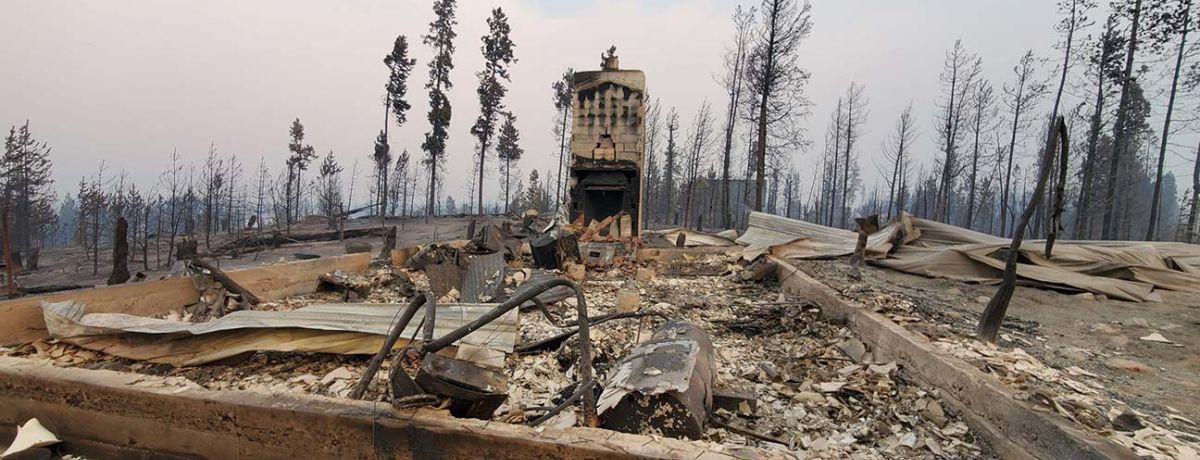
Home Construction in Wildfire Prone Areas: A Grand County Story
Grand County is full of helpful neighbors and connected communities. When something bad happens to us, our neighbors bring us food. When snow hits our streets, neighbors steadfastly remove snow from around our communities’ fire hydrants. These are good people, and we appreciate what they do for us. I recently found another kind of good neighbor when I met Bob and Eileen Hunnes. Their way of being a good neighbor extends beyond casseroles and snow shoveling, to reducing wildfire risk for themselves and those around them through home hardening.
This neighborly story began when the Hunnes’ lost their family home in the East Troublesome fire. Bob is an engineer, and his son works in the construction industry in California. Together they built a wonderful retreat in a dense lodgepole forest. They mitigated their landscape, but unfortunately still lost their home to the embers of the fire.
In the United States firefighters are able to control wildfires without significant destruction to property about 98% of the time according to the National Fire Protection Association. However, wildfire control can fail during extreme fire conditions. During the Fourmile Canyon Fire in Boulder in 2010, it was determined that 83% of the homes that were destroyed were because of the embers, not from the flame front which passed by fairly quickly. These embers occur with all fires, and get into wood piles, corners of your deck, and other nooks and crannies. They smolder, sometimes for days, before they ignite your home. Home hardening is the process of using fire resistant building materials, which gives our homes the chance of surviving a wildfire. It also gives us time to evacuate safely and firefighters more opportunity to save our home.
The Hunnes’, with the help of Steve Jensen, owner of Mountain Top Builders, set out to create a new home that would be as ignition resistant as possible during a wildfire. Roofs, with their large surface area, can quickly become a liability if they are not fire resistant under a shower of embers. The Hunnes’ new roof was built using Sips prefabricated panels, which have styrofoam around the wood. Around that they added a gypsum sheathing, which is known to keep out moisture and mold, and is also fire retardant. On top of that went the metal roof and the metal fascia. There are no soffit vents, and the soffits are covered with gypsum sheathing and stucco. These layers of materials provide a fire resistant roof.
Another great method of home hardening can be found behind the Hunnes’ fire-resistant stucco, rock, and metal walls. They used an insulation material called rock wool, which is used extensively in Europe and was more common here before cheaper alternatives were created. Rock wool does not burn. During my tour of the home, we also talked about their triple-paned, tempered glass windows. During extreme heat, glass will break. Having tempered glass gives your windows a fighting chance of staying in the frame even though they are cracked, which stops embers from entering your home through the windows. Having three panes of glass also reduces radiant heat from the fire, which lowers your risk of your blinds igniting.
The Hunnes’ have created a home that can withstand a flurry of embers. If their home does not ignite, the chance of their neighbor’s homes igniting is also reduced. Structure-to-structure ignition can cause ordinary fires to become extraordinary fires very quickly. During the Waldo Canyon fire in 2012, there were 60-100 home ignitions each hour! The firefighters simply could not keep us. In a fire in California with a different outcome, the fire front approached a house that was built with fire-resistant materials and had a mitigated landscape. The fire split around the house in a large V, saving that house and the 8 homes behind it. Seems to me that is right neighborly!
A fire-resistant home is all well and good, but how much does this cost? Fire-resistant materials are quickly becoming similar in cost to non fire-resistant materials for new builds. If you’re looking to build a new home in Grand County, talk to your builder and your architect about how to design a home that will be more fire resistant. In the near future, some of these fire-resistant materials may be required for all new construction in the Wildland Urban Interface - where you live or have a second home.
For existing homes, we recommend that when you need to replace your roofing, siding, decking, windows, etc., that you look into using fire-resistant materials. You will be making your home safer for yourself and your neighbors. If you cannot afford to use fire-resistant materials, another important step in wildfire risk reduction is reducing the combustible fuels around your home, such as removing shrubs, thinning trees, and moving firewood further from the home.
If you are interested in learning more but not sure where to begin, the Grand County Wildfire Council and our fire district partners offer free wildfire risk assessments for your property, where you will learn about your home’s specific wildfire vulnerabilities. Please reach out to your local fire district or get in touch with us at
Being a Good Neighbor By Reducing Your Wildfire Risk
Mary Sangster, Board Secretary and Education Committee Chair
Grand County Wildfire Council